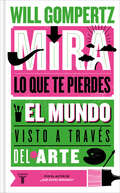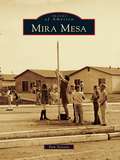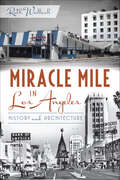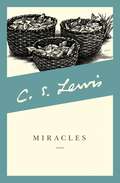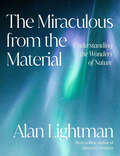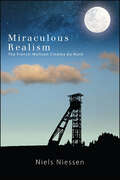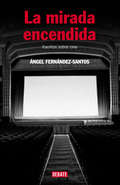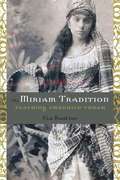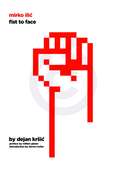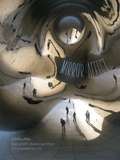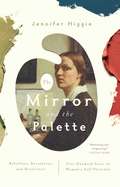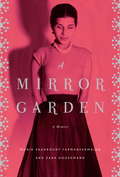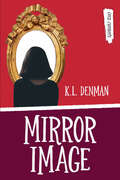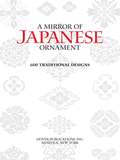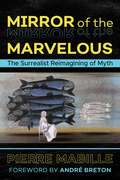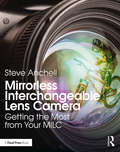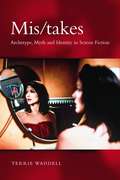- Table View
- List View
Mira lo que te pierdes: El mundo visto a través del arte
by Will GompertzVuelve la fresca sabiduría de Gompertz para enseñarnos a mirar como artistas y experimentar una nueva manera de estar en el mundo. Los artistas han aprendido a prestar atención. El resto de los mortales, sin embargo, pasamos la mayor parte del tiempo con el piloto automático, corriendo de aquí para allá, y nuestra excesiva familiaridadcon lo que nos rodea nos ciega ante el sinfín de maravillosos fenómenos que afirman la vida. Pero no tiene por qué ser así. A su más puro estilo, Will Gompertz nos lleva a la mente de los artistas, desde estrellas contemporáneas hasta viejos maestros, desde los más famosos hasta algunos menos conocidos, a lo largo y ancho del mundo, para mostrarnos cómo mirar y experimentar el mundo con mayor conciencia.Tras leer Mira lo que te pierdes disfrutamos contemplando el cielo en días nublados como el pintor romántico John Constable; Hockney se convierte en el nuevo guía de nuestros paseos por el bosque; entendemos qué es de verdad una amapola gracias a Georgia O'Keeffe; y Rembrandt nos contagia su valentía a la hora de mirarnos a nosotros mismos. Este libro nos ofrece la estimulante sensación de estar verdaderamente vivos. La crítica ha dicho:«Will Gompertz es un tipo singular. Rápido como la sangre. Y un defensor de la claridad en un territorio de opacidades».Antonio Lucas, El Mundo «Gompertz es tan provocador, irreverente, irónico, divertido y políticamente incorrecto como muchos de los artistas de los que habla. Su visión del mundo del arte es inteligente, salpimentada con buenas dosis de humor».Nati Pulido, ABC«Will Gompertz es de esa estirpe de profesionales que, porque de verdad saben, no necesitan demostrar nada. Aúna sencillez, hondura y falta de afectación».Hoyesarte.com «A Gompertz se le da mal ser aburrido».The Times «Gompertz es el mejor profesor que has tenido jamás».The Guardian
Mira Mesa
by Pam StevensMira Mesa is a suburban community in the northern part of the city of San Diego with many qualities of a small town. Mira Mesa is San Diego's largest suburb, with over 75,000 residents, stretching from Marine Corps Air Station Miramar on the south to Los Peñasquitos Canyon Preserve on the north, and from I-15 on the east to I-805 on the west. When rapid growth in the early 1970s transformed the mesa from rocks and rattlesnakes to tract homes, there were no schools, parks, or other facilities, not even a grocery store. Residents held rallies and marches, and the first schools in Mira Mesa were created inside houses leased from developers. Mira Mesa today is a happily multiethnic community that includes schools, parks, a library, industrial and retail centers, and several supermarkets.
Miracle in the Evening: An Autobiography
by Norman Bel GeddesMIRACLE IN THE EVENING is the autobiography of one of the most brilliant stage and industrial designers of our time. Norman Bel Geddes’ story is the drama of a young man who, having worked his way through school, climaxed a brilliant career with ideas that gave birth to some of the most spectacular theatrical productions of the last half century.Through Norman Bel Geddes’ story, as through the theater itself, pass the many colorful personalities of our age, lending brilliance and scope, good humor and compelling human interest.The life story of this ingenuous man is filled with names of the glittering and the great, such as Frank Lloyd Wright, Madame Schumann-Heink (his first portrait-sketch was of this famous contralto), Will Rogers, Charlie Chaplin, David Belasco, Horace Liveright, J. Walter Thompson, Walter Chrysler, Harold Ross, and many others—a fascinating story of a man who has more than once created for audiences a MIRACLE IN THE EVENING.
Miracle Mile in Los Angeles: History and Architecture
by Ruth WallachThe world-famous Miracle Mile in Los Angeles was shaped into a great commercial and cultural district by the city's tremendous urban expansion in the early twentieth century. Its origins along Wilshire Boulevard are directly related to the twin LA booms in auto travel and real estate ventures. Once the home of such famous stores as the May Company, Silverwood's, Coulter's and Desmond's, as well as Streamline Moderne and Art Deco architecture, Miracle Mile has boasted the La Brea Tar Pits and Farmer's Market, Gilmore Field and CBS Television City, as well as Pan Pacific Park and Museum Row. Join author Ruth Wallach, head of the University of Southern California's Architecture and Fine Arts Library, for this tour through the most emblematic neighborhood of twentieth-century Los Angeles development.
The Miracle of Clarence W. Jones & HCJB
by Lois Neely"Go south with radio," God said to Clarence Wesley Jones. So C. W. went south--to Ecuador. Come up to this mountain," God said. Clarence Jones ascended the mountain and perched his tiny radio operation in Quito, the city at the "top of the world." Lord, C. W. prayed then, give me this mountain. And so it was that in 1931, in a humble sheepshed rigged with a 250-watt transmitter and antenna wire, a Christmas program was broadcast to a total of just thirteen receiving sets, and HCJB was born. It was the advent of missionary radio. Come Up to This Mountain is the inspiring story of HCJB and the pioneering missionary spirit of C. W. Jones. A man of dreams, relentless energy, and immense practicality, C. W. Jones took that "soft whisper of the Andes" and, through hardship and tragedy, built it into a massive 500,000-watt radio center, a "mighty shout echoing around the globe." Give me this mountain, said C. W. Jones. And God gave him the world.
Miracles
by C. S. LewisIn the classic Miracles, C.S. Lewis, the most important Christian writer of the 20th century, argues that a Christian must not only accept but rejoice in miracles as a testimony of the unique personal involvement of God in his creation.
Miracles and Sacrilege
by William Bruce JohnsonMiracles and Sacrilege is the story of the epochal conflict between censorship and freedom in film, recounted through an in-depth analysis of the U.S. Supreme Court?s decision striking down a government ban on Roberto Rossellini?s film The Miracle (1950). In this extraordinary case, the Court ultimately chose to abandon its own longstanding determination that film comprised a mere ?business? unworthy of free-speech rights, declaring for the first time that the First Amendment barred government from banning any film as ?sacreligious.?Using legal briefs, affidavits, and other court records, as well as letters, memoranda, and other archival materials to elucidate what was at issue in the case, William Bruce Johnson also analyzes the social, cultural, and religious elements that form the background of this complex and hard-fought controversy, focusing particularly on the fundamental role played by the Catholic Church in the history of film censorship. Tracing the development of the Church in the United States, Johnson discusses the reasons it found The Miracle sacrilegious and how it attained the power to persuade civil authorities to ban it. The Court?s decision was not only a milestone in the law of church-state relations, but it paved the way for a succession of later decisions which gradually established a firm legal basis for freedom of expression in the arts.
The Miraculous from the Material: Understanding the Wonders of Nature
by Alan LightmanA gorgeously illustrated exploration of the science behind the universe&’s most stunning natural phenomena—from atoms and parameciums to rainbows, snowflakes, spider webs, the rings of Saturn, galaxies, and moreNature is capable of extraordinary phenomena. Standing in awe of those phenomena, we experience a feeling of connection to the cosmos. For acclaimed physicist and novelist Alan Lightman, just as remarkable is that all of what we see around us—soap bubbles, scarlet ibises, shooting stars—are made out of the same material stuff and obey the same rules and laws. This is what Lightman calls &“spiritual materialism,&” the belief that we can embrace spiritual experiences without letting go of our scientific worldview.Pairing 36 beautiful, full-color photos evoking some of nature&’s most awe-inspiring phenomena with accessible and lyrical personal essays, The Miraculous from the Material explores the fascinating science underlying the natural world. Why do rainbows make an arc? Why does a particular waterfall at Yosemite National Park sometimes glow like it&’s on fire? How does a hummingbird fly? The world has so many things to marvel at—and the science is just as fascinating.Lightman&’s imagination travels from the world of atoms and molecules to the animal kingdom, from places like Ha Long Bay, Vietnam and the Grand Canyon out to the solar system and beyond, illuminating the majesty of the cosmos and the remarkable science behind it. The Miraculous from the Material is a stunning, soaring ode to the beauty and wonder around us, and the perfect holiday gift for photography aficionados, life-long learners, and admirers of the natural world.
Miraculous Realism: The French-Walloon Cinéma du Nord (SUNY series, Horizons of Cinema)
by Niels NiessenAt the 1999 Cannes Film Festival, two movies from northern-Francophone Europe swept almost all the main awards. Rosetta by the Walloon directors Jean-Pierre and Luc Dardenne won the Golden Palm, and L'humanité by the French director Bruno Dumont won the Grand Prize; both won acting awards as well. Taking this "miracle" of Cannes as the point of departure, Niels Niessen identifies a transregional film movement in the French-Belgian border region—the Cinéma du Nord or "cinema of the North." He examines this movement within the contexts of French and Belgian national cinemas from the silent era to the digital age, as well as that of the new realist tendency in world cinema of the last three decades. In addition, he traces, from a northern perspective, a secular-religious tradition in Francophone-European film and philosophy from Bresson and Pialat, via Bazin, Deleuze, and Godard, to the Dardennes and Dumont, while critiquing this tradition for its frequent use of a humanist vocabulary of grace for a secular world. Once a cradle of the Industrial Revolution, the Franco-Belgian Nord faced economic crisis for most of the twentieth century. Miraculous Realism demonstrates that the Cinéma du Nord's rise to prominence resulted from the region's endeavor to reinvent itself economically and culturally at the crossroads of Europe after decades of recession.
La mirada encendida: Escritos sobre cine
by Ángel Fernández-SantosÁngel Fernández-Santos fue hasta su muerte, en 2004, la figura más prestigiosa y reconocida de la crítica cinematográfica española, no sólo por su titularidad desde 1982 como crítico del diario El País, sino porque para muchos aficionados al cine en nuestro paísél encarnaba plenamente la condición de crítico cinematográfico y representaba una tradición en vías de extinción: aquella crítica capaz de aunar el conocimiento y la pasión, la atracción por el cine y la dimensión literaria de la escritura sobre cine, el compromiso y el placer del espectador atento y privilegiado. Esta obra recoge, gracias a la extraordinaria tarea del crítico e historiador del cine Carlos Heredero, casi cuarenta años de críticas de películas, reflexiones sobre el cine y perfiles de directores y actores, y supone un imprescindible recorrido por el séptimo arte, su grandeza y su magia, de la mano de uno de sus mejores conocedores e intérpretes.
The Mirage of America in Contemporary Italian Literature and Film
by Barbara AlfanoThe Mirage of America in Contemporary Italian Literature and Film explores the use of images associated with the United States in Italian novels and films released between the 1980s and the 2000s. In this study, Barbara Alfano looks at the ways in which the individuals portrayed in these works - and the intellectuals who created them - confront the cultural construct of the American myth. As Alfano demonstrates, this myth is an integral part of Italians' discourse to define themselves culturally - in essence, Italian intellectuals talk about America often for the purpose of talking about Italy.The book draws attention to the importance of Italian literature and film as explorations of an individual's ethics, and to how these productions allow for functioning across cultures. It thus differentiates itself from other studies on the subject that aim at establishing the relevance and influence of American culture on Italian twentieth-century artistic representations.
The Miriam Tradition: Teaching Embodied Torah
by Cia SautterThe Miriam Tradition works from the premise that religious values form in and through movement, with ritual and dance developing patterns for enacting those values. Cia Sautter considers the case of Sephardic Jewish women who, following in the tradition of Miriam the prophet, performed dance and music for Jewish celebrations and special occasions. She uses rabbinic and feminist understandings of the Torah to argue that these women, called tanyaderas, "taught" Jewish values by leading appropriate behavior for major life events. Sautter considers the religious values that are in music and dance performed by tanyaderas and examines them in conjunction with written and visual records and evidence from dance and music traditions. Explaining the symbolic gestures and motions encoded in dances, Sautter shows how rituals display deeply held values that are best expressed through the body. The book argues that the activities of women in other religions might also be examined for their embodiment and display of important values, bringing forgotten groups of women back into the historical record as important community leaders
Mirko Ilic: Fist to Face
by Dejan KrsicMirko Ilic has a reputation as a rebel, but his iconoclasm is matched with tremendous gifts as an illustrator, a designer, and an educator. Ilic is a visionary and a leading voice of visual culture across disciplines and continents.This visual biography of one of the most prolific and distinguished designers of the last half century traces Ilic's formative years as a precocious youth in Yugoslavia during the Communist-bloc era; his early illustrations for comic books and magazines; and his eventual move to the United States, where he quickly achieved notoriety as the art director of Time magazine's international edition and The New York Times' op-ed pages. As a designer, Ilic has constantly pushed his craft to new limits, experimenting and reinventing himself at every turn.Throughout his illustrious career, Ilic has collaborated with design luminaries like Steven Heller and Milton Glaser. He has designed album covers for Rage Against the Machine, created film titles for You've Got Mail, and written or designed a number of books, including Genius Moves, The Design of Dissent, The Anatomy of Design, and Stop Think Go Do.He has taught advanced design classes at Cooper Union with Milton Glaser and now teaches illustration at the School of Visual Arts. His studio, Mirko Ilic Corp., has received awards from the Society of Publication Designers, the Art Directors Club, I.D., Print, and HOW.
Mirko Ilic
by Dejan KrsicMirko Ilic has a reputation as a rebel, but his iconoclasm is matched with tremendous gifts as an illustrator, a designer, and an educator. Ilic is a visionary and a leading voice of visual culture across disciplines and continents. This visual biography of one of the most prolific and distinguished designers of the last half century traces Ilic's formative years as a precocious youth in Yugoslavia during the Communist-bloc era; his early illustrations for comic books and magazines; and his eventual move to the United States, where he quickly achieved notoriety as the art director of Time magazine's international edition and The New York Times' op-ed pages. As a designer, Ilic has constantly pushed his craft to new limits, experimenting and reinventing himself at every turn. Throughout his illustrious career, Ilic has collaborated with design luminaries like Steven Heller and Milton Glaser. He has designed album covers for Rage Against the Machine, created film titles for You've Got Mail, and written or designed a number of books, including Genius Moves, The Design of Dissent, The Anatomy of Design, and Stop Think Go Do. He has taught advanced design classes at Cooper Union with Milton Glaser and now teaches illustration at the School of Visual Arts. His studio, Mirko Ilic Corp., has received awards from the Society of Publication Designers, the Art Directors Club, I.D., Print, and HOW.
Mirko Ilic
by Dejan KrsicMirko Ilic has a reputation as a rebel, but his iconoclasm is matched with tremendous gifts as an illustrator, a designer, and an educator. Ilic is a visionary and a leading voice of visual culture across disciplines and continents. This visual biography of one of the most prolific and distinguished designers of the last half century traces Ilic's formative years as a precocious youth in Yugoslavia during the Communist-bloc era; his early illustrations for comic books and magazines; and his eventual move to the United States, where he quickly achieved notoriety as the art director of Time magazine's international edition and The New York Times' op-ed pages. As a designer, Ilic has constantly pushed his craft to new limits, experimenting and reinventing himself at every turn. Throughout his illustrious career, Ilic has collaborated with design luminaries like Steven Heller and Milton Glaser. He has designed album covers for Rage Against the Machine, created film titles for You've Got Mail, and written or designed a number of books, including Genius Moves, The Design of Dissent, The Anatomy of Design, and Stop Think Go Do. He has taught advanced design classes at Cooper Union with Milton Glaser and now teaches illustration at the School of Visual Arts. His studio, Mirko Ilic Corp., has received awards from the Society of Publication Designers, the Art Directors Club, I.D., Print, and HOW.
Mirror Affect: Seeing Self, Observing Others in Contemporary Art
by Cristina AlbuFor decades, contemporary artworks with reflective properties have stimulated public forms of spectatorship. According to Cristina Albu, these artworks, which can include elements such as mirrors, live video feedback, or sensors, draw attention to affective interdependence and mechanisms of social control. In Mirror Affect, Albu provides a historical account of mirroring processes in contemporary art and offers insight into the phenomenological and sociopolitical concerns that have inspired artists to stage processes of affective, perceptual, and behavioral mirroring between art viewers. Beginning with the 1960s, Albu charts the rise of interpersonal modes of art spectatorship. She reveals contemporary artists&’ strategic use of reflective and responsive interfaces to instill doubt in visual representation and appeal to active scrutiny of the changing social dynamics. She suggests that the mirroring processes envisioned by contemporary artists such as Joan Jonas, Dan Graham, Lynn Hershman Leeson, Olafur Eliasson, and Rafael Lozano-Hemmer trigger visual disjunctions to upset narcissistic inclinations. They invite viewers to see themselves in relation to others and to ponder their role within complex social systems.From sculpture and performance to art and technology projects, video art, and installation art, Mirror Affect analyzes forms of interpersonal spectatorship, revising and expanding current historiographies of participatory art.
The Mirror and the Palette: Rebellion, Revolution and Resilience: 500 Years of Women's Self-Portraits
by Jennifer HiggieHer story weaves in and out of time and place. She's Frida Kahlo, Loïs Mailou Jones and Amrita Sher-Gil en route to Mexico City, Paris or Bombay. She's Suzanne Valadon and Gwen John, craving city lights, the sea and solitude; she's Artemisia Gentileschi striding through the streets of Naples and Paula Modersohn-Becker in Worpswede. She's haunting museums in her paint-stained dress, scrutinising how El Greco or Titian or Van Dyck or Cézanne solved the problems that she too is facing. She's railing against her corsets, her chaperones, her husband and her brothers; she's hammering on doors, dreaming in her bedroom, working day and night in her studio. Despite the immense hurdles that have been placed in her way, she sits at her easel, picks up a mirror and paints a self-portrait because, as a subject, she is always available. Until the twentieth century, art history was, in the main, written by white men who tended to write about other white men. The idea that women in the West have always made art was rarely cited as a possibility. Yet they have - and, of course, continue to do so - often against tremendous odds, from laws and religion to the pressures of family and public disapproval. In THE MIRROR AND THE PALETTE, Jennifer Higgie introduces us to a cross-section of women artists who embody the fact that there is more than one way to understand our planet, more than one way to live in it and more than one way to make art about it. Spanning 500 years, biography and cultural history intertwine in a narrative packed with tales of rebellion, adventure, revolution, travel and tragedy enacted by women who turned their back on convention and lived lives of great resilience, creativity and bravery. This is a dazzlingly original and ambitious book by one of the most well-respected art critics at work today.
The Mirror and the Palette: Rebellion, Revolution, And Resilience: Five Hundred Years Of Women's Self Portraits
by Jennifer HiggieA dazzlingly original and ambitious book on the history of female self-portraiture by one of today's most well-respected art critics.Her story weaves in and out of time and place. She's Frida Kahlo, Loïs Mailou Jones and Amrita Sher-Gil en route to Mexico City, Paris or Bombay. She's Suzanne Valadon and Gwen John, craving city lights, the sea and solitude; she's Artemisia Gentileschi striding through the streets of Naples and Paula Modersohn-Becker in Worpswede. She's haunting museums in her paint-stained dress, scrutinising how El Greco or Titian or Van Dyck or Cézanne solved the problems that she too is facing. She's railing against her corsets, her chaperones, her husband and her brothers; she's hammering on doors, dreaming in her bedroom, working day and night in her studio. Despite the immense hurdles that have been placed in her way, she sits at her easel, picks up a mirror and paints a self-portrait because, as a subject, she is always available. Until the twentieth century, art history was, in the main, written by white men who tended to write about other white men. The idea that women in the West have always made art was rarely cited as a possibility. Yet they have - and, of course, continue to do so - often against tremendous odds, from laws and religion to the pressures of family and public disapproval. In The Mirror and the Palette, Jennifer Higgie introduces us to a cross-section of women artists who embody the fact that there is more than one way to understand our planet, more than one way to live in it and more than one way to make art about it. Spanning 500 years, biography and cultural history intertwine in a narrative packed with tales of rebellion, adventure, revolution, travel and tragedy enacted by women who turned their back on convention and lived lives of great resilience, creativity and bravery.
A Mirror Garden: A Memoir
by Zara Houshmand Monir FarmanfarmaianIn Persia in 1924, when a child still had to worry about hostile camels in the bazaar and a nanny might spin stories at her pillow until her eyes fell shut, the extraordinary and irresistible Monir Shahroudy Farmanfarmaian was born. From the enchanted basement storeroom where she played as a girl to the penthouse high above New York City where she would someday live, this is the delightful and inspiring story of her life as an artist, a wife and mother, a collector, and an Iranian. Here we see a mischievous girl become a spirited woman who defies tradition. Both a love story and a celebration of the warmth and elegance of Iranian culture, A Mirror Garden is a genuine fairy tale of an exuberant heroine who has never needed rescuing.From the Trade Paperback edition.
Mirror Image (Orca Currents)
by K.L. DenmanSable wears only black and has always felt that doom is near. Lacey wears pink and seeks beauty everywhere. A sadistic art teacher pairs Sable and Lacey together for their final project. The girls have to get to know one another and select a suitable poem for the back of each other's decorative mirror. Sable is less than thrilled at having to spend time with Lacey, who she believes to be nothing more than a brainless doll. As the project progresses, and Sable gets past her resentment, she learns some surprising truths about who Lacey really is. All of Sable's images begin to change, including the one she holds of herself. This short novel is a high-interest, low-reading level book for middle-grade readers who are building reading skills, want a quick read or say they don’t like to read! The epub edition of this title is fully accessible.
A Mirror of Japanese Ornament: 600 Traditional Designs
by DoverRendered from a rare 1915 five-volume set, this all-encompassing design treasury captures the graceful beauty of traditional Japanese motifs. These 100 full-color plates--many with multiple images--range from ornate florals and elegant cranes to dragons and Buddhas, and from Silk Road imports to Edo-style textile patterns.A veritable grammar of Japanese ornament, this compilation includes an Introduction, Chronology, and Bibliography, as well as captions translated from the original Japanese notes. In addition to their applications for fabric and wallpaper designs, these vivid royalty-free images are ideal for a tremendous variety of graphics projects, and are, in addition, a treat for connoisseurs of Japanese art.
Mirror of the Marvelous: The Surrealist Reimagining of Myth
by Pierre Mabille André BretonA surrealist exploration of the marvelous in ancient, classic, and modern works from around the world • Long considered one of the most significant and original books to have come out of the surrealist movement • Reveals the “marvelous” in works from William Blake, Edgar Allen Poe, William Shakespeare, Chrétien de Troyes, and Arthur Rimbaud; legends and folktales from around the world; classics from Ovid, Plato, and Apuleius; Masonic ritual texts, Mesopotamia’s Epic of Gilgamesh, the Popol-Vuh, Lewis Caroll’s Alice through the Looking Glass, Solomon’s Song of Songs, and Goethe’s Faust First published in French as Miroir du merveilleux in 1940, Mirror of the Marvelous has long been considered one of the most significant and original books to have come out of the surrealist movement and Anaïs Nin suggested it as a source of inspiration, far ahead of its time. Drawing on sacred and modern texts that share a quality of the marvelous, Pierre Mabille defines “the marvelous” as the point at which inner and outer realities are joined and the individual is simultaneously one with himself and with the world, thus recovering the true sense of the sacred. He shows how “the marvelous” goes beyond simply being a synonym for “the fantastic” to engage the entire emotional realm. Mabille cites a far-reaching range of texts, from the classic to the obscure, from Egyptian myth to Voodoo initiation ceremonies, from the ancient epic to the modern poem, from the creation myth to more contemporary visions of apocalypse. He includes surrealist analyses of works from William Blake, Edgar Allen Poe, William Shakespeare, Chrétien de Troyes, and Arthur Rimbaud; legends and folktales from Egypt, Iceland, Mexico, Africa, India, and other cultures; classics from Ovid, Plato, and Apuleius; Masonic ritual texts, Mesopotamia’s Epic of Gilgamesh, the Popol-Vuh, Lewis Caroll’s Alice through the Looking Glass, Solomon’s Song of Songs, and selections from Goethe’s Faust. Mirror of the Marvelous actively defines the flame of the marvelous by showing its presence in those works where it burns the brightest.
Mirrorless Interchangeable Lens Camera: Getting the Most from Your MILC
by Steve AnchellMirrorless interchangeable lens cameras are changing the way images are captured, being far more in line with modern photography trends and sensibilities. With Mirrorless Interchangeable Lens Camera: Getting the Most from Your MILC, you’ll learn why this is happening and how to get the most from your mirrorless camera. This guide covers everything you need to know about the difference between a mirrorless camera and a DSLR, apps, lenses, video recording, and picture profiling features. You’ll learn how to use your mirrorless interchangeable lens camera for different genres of photography including landscape, travel, low light, street photography, portraiture, and more. Written by expert and skilled instructor Steve Anchell, this book includes 198 inspirational and instructional images with 154 in full-color, with insights and photographs from 9 professional photographers. It’s the perfect guide for established photographers not yet aware of the wealth of benefits mirrorless interchangeable lens cameras offer and for beginning photographers just starting their career.
Mirrors and Scrims
by Marcia B. SiegelIn this stunning new collection of reviews and essays, dance critic Marcia B. Siegel grapples with the floating identity of ballet, as well as particular ballets, and with the expanding environment of spectacle in which ballet competes for an audience. Drawn from a wide variety of published sources, these writings concentrate on canonical works of ballet and how the performances of these works have been changing in significant ways. Siegel writes with a keen awareness of the history and mythology that surround particular works, while remaining attentive to the new ways in which a work is interpreted and re-presented by contemporary choreographers and dancers. Through her readable and provocative writings, Siegel offers critical insight into performances of the past twenty-five years to give us a new understanding of ballet in performance. The volume includes over one hundred pieces on a variety of ballet topics, from specific dances and dancers to companies and choreographers, ranging from Swan Lake and The Nutcracker to Nijinsky, Balanchine, Tharp, and Morris to the Bolshoi, the Joffrey, the Miami City Ballet, the Boston Ballet, to name just a few.
Mis/takes: Archetype, Myth and Identity in Screen Fiction
by Terrie WaddellMis/takes departs from the bulk of screen discourse by applying Jungian and Post-Jungian ideas on unconscious processes to popular film and television. This perspective offers a rich insight into the way that various myths infiltrate popular culture. By examining the function of psychological motifs and symbols in cinema and television, Terrie Waddell opens up another way of thinking about how identity can be constructed and disrupted. Mulholland Drive, Memento, The Others, The X-Files, Twin Peaks, The Sopranos, Spider, Intimacy and Absolutely Fabulous all lend themselves to this approach. The close analysis of these films/programs are guided by a number of core archetypes from trickster and Self to incest and the grotesque. The book’s four parts reflect these dominant patterns: Jung, trickster and the screen Mistaken identities, self-deception and the undead Redeemers, bad dads and matricide Excesses of the sad and the sassy Mis/takes gives readers a chance to engage with screen material in an original and subversive way. This study will be of great interest to Jungian analysts and students of film, cultural studies, media, gender studies and analytical psychology.
